Second Excursion.
THE district round Collingham was chosen for the second summer excursion, and Tuesday August 15th, fixed as its date. Accordingly, on the morning of that day, a party numbering nearly sixty, assembled at Newark and started thence in brakes, by way of the pretty village of Winthorpe, for the outlying hamlet of Holme, which stands, slightly elevated, on a natural mound of sand on the east bank of the river Trent. After a short time had been devoted to looking round the exterior of the interesting church of St. Giles, the party collected in the Barton chapel within the building, where the following paper was read by Mr. T. M. Blagg, F.S.A., of Newark, upon whom the burden of reading papers descriptive of the various churches, fell somewhat heavily throughout the day.
Mr. T. M. BLAGG'S PAPER.
Thoroton says "The hamlet of Holme seems to be on the other side of the Trent, but is not so, for that betwixt North Muskham and Holme is but a new stream, and the old current was beyond the utmost part of Holme, and that ditch, now dried up, is still the limits between the Wapentakes of Thurgarton a Lee and Newark." Dickinson and Throsby add that the Trent here changed its course about the year 1600, but as Saxton in his map of Notts., published about 1576, places Holme on the eastern bank, I conclude that the change took place before the latter date. In 1575, Stephen Surflett, of Holme, left some land here for the up-keep of the flood bank, and the rents are still used for that purpose. I think it probable that this indicates that the change had taken place during Surflett's life-time, i.e., previous to 1575.
Territorially in the Wapentake of Thurgarton a Lee, ecclesiastically, Holme was a chapelry under the jurisdiction of the Peculiar Court of Southwell, in the muniments of which church we must look for the wills, register transcripts, presentments, and other records relating to the place and its people.
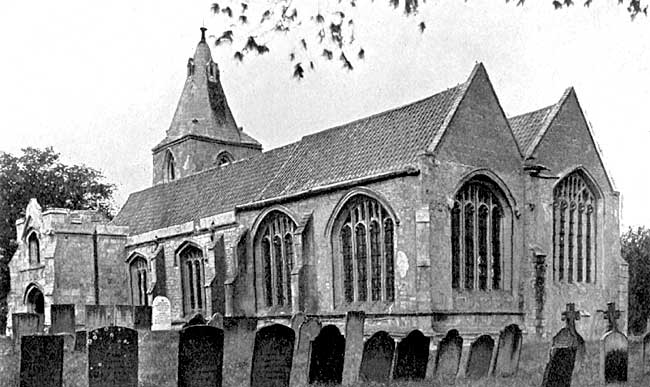
St Giles' church, Holme.
This quaint church of St. Giles, with its air of hoary antiquity, is in reality the least ancient of the churches which we visit to-day, being chiefly of the Perpendicular and Tudor periods. Its archaic appearance is due to three centuries of absolute neglect, so that the very benches and pews used now under King Edward VII. are the same as were used in the reign of the seventh Henry.
Perhaps the earliest portion of the present church is the north wall of the nave (which does not appear to have ever been pierced by windows), the nail-head enrichment on the capitals of the northern door, with its plain chamfered arch, stamping it as of the Early English period. The northern wall leans greatly outward, and is upheld by large brick buttresses of the 18th century. The windows in the upper stage of the tower are of a Decorated type, but the embattled capitals of the tower arch assign it to the Perpendicular period, of which the large west window is characteristic. To this period and the latter end of it, the years which immediately preceded the Reformation, belongs the greater part of the present church. Its rebuilding and embellishment at this time it owed to the Barton family of Lancashire, one of whom, John Barton, probably married a lady of the Gernon family of the neighbouring hamlet of Little Carlton, where Thoroton tells be they had held property for 400 years. At any rate, Barton assumed the Gernon shield for his arms, merely accompanying it with his initials or with his rebus of a bear and a tuna In Holme, Thoroton says, he built “a fair stone house” and put in the windows this “posie” :—
“I thanke God, and ever shall,
It was the shepe hath payed for all.”
His immense fortune having been acquired as a merchant of the staple. This house stood a quarter of a mile S.W. of the church, on a site now occupied by a modern farmhouse, but the predecessor of which, pulled down only a few years ago, contained a chimney-piece bearing the Barton arms, while the “posie” quoted by Thoroton was built into the fabric of the stables.
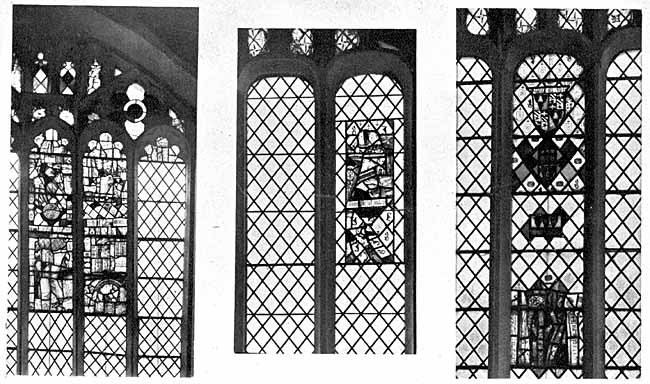
Old glass, Holme church.
Thoroton also tells us that Barton built “a fair chapel like a Parish Church” at this place. This “fair chapel” is obviously (lie south aisle of the present chancel, while time whole (if time chancel, south aisle of nave, the porch and its parvise, testify to Barton’s piety and munificence. The original will of this John Barton is preserved in Nottingham Castle Museum, and also has been printed in Test: Ebor: vol. iv., p. 61. It is a document of great interest, dated 10th December, 1490, and proved at Scrooby 13th June, 1491, and at Calais 28th June in the same year. The testator describes himself as John Barton, of Holme, by Newark, merchant of the staple of Calais, and he directs his body to be buried “in my new tomb in the chapel newly constructed by me in Holme”—thus fixing definitely both the date of the enlargement of the church and the identity of the figure on the tomb. He mentions his wife Isabella; his son Ralph, and his wife Joan, and their son and heir, John; his sons Thomas, Robert, and Richard; his daughters Katherine and Isabella Tamworth, and his sisters Margaret Spencer and Marian. He directs that his son Ralph shall find a fit priest to celebrate divine service for the salvation of his soul in the chapel at Holme.
There is no chancel arch. The chapel is separated from the chancel by an arcade of two unequal arches, their capitals having an unusual ornamentation of square projecting bosses. The western arch is occupied by the parclose screen, the eastern by the Barton tomb. This bears the recumbent effigies of Barton and his wife, he clothed as a merchant of the 15th century, with his feet resting on a tun, those of the lady on a dog. Beneath the “mensa” of the tomb lies a “cadaver” or corpse, with on each side the quotation, in Latin, from the Book of Job, “Pity me, pity me, you at least my friends, for the hand of the Lord has touched me.”
Let into the floor under the present altar is a pre-Reformation altar slab, with its incised crosses.
The room over the porch is known as “Nan Scott’s Chamber,” from the legend that an old woman named Ann Scott made it her dwelling during the time that holme was visited by the plague in the 17th century. It contains an ancient chest with a coped lid, much dilapidated, possibly of the 15th century.
The Bells are three in number and of some interest.
No. 1 has the founders’s mark of Henry Oldfield, of Nottingham, and bears the date 1592, and time legend “RAVFE BARTOVN ES QVIER DID GIVE THIS BELL.”
No. 2 the oldest, appears to be of 15th century workmanship, and has only its name, TOBIAS, in single Lombardic capitals.
No. 3 is a Commonwealth bell, with the founder’s mark of George Oldfield, and the date 1657, and legend, “GOD SAVE THE CHVRCH.”
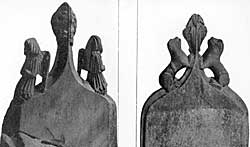
Bench ends, Holme church.
The 15th century bench ends should he noticed—eagles, lions, talbots, chameleons, and cherubim being figured. The stained glass is of much interest, although it is fragmentary and inserted with no regard for its proper position; for instance, there is part of a figure of a bishop in the north-east window of the chancel, represented in chasuble and dalmatic, but it is upside down. Everywhere, in stone and glass, is scattered the initial “B” of Barton, their rebus of a tun, and their merchant’s mark.
The details of stonework in the Barton chapel are worthy of notice, in the South wall is a beautiful piscina, with flower-formed drain, the holes pierced at the junction of the petals; over time arched recess is a crocheted ogee hood mould the flanking pinnacles and the finial are gone. On either side of the cast window are canopied niches ; projecting from the underside (if the northern most is the figure of a deacon in a dalmatic, holding a chalice. Above the eastern arch is a bust of his Satanic Majesty. The Tudor rose is a distinctive feature in the ornament,
The Barton estates here passed by marriage to the family of Bellasis, of whom one was the gallant Governor of Newark during its last seige. On the floor of the Barton chapel is a slab inscribed:—
Here lie interred ye Body of
John Belasys of Holme in the
County of Nottingham, Esquire,
And of Catherine, his wife. Catherine
Dyed the 10th of March, 1716, and
Mr. Belasyse the 10th of Aprill, 1717.
Requiecscant in Pace.”
The only other inscription in the church is a brass Plate in time North aisle of the nave to John Randolph, son of the Rev. Randolph Marriott and Ann, his wife, who died of the typhus fever March 6th, 1812, at Newark, in the 14th year of his age.
The original roof of the church has disappeared, though the corbels which supported it remain. The line of the original depressed roof of the South aisle may lie seen from the outside at the west end. Seated on its sandy knoll, with its low broached spire of grey stone, the church’s present twin roofs of warm red pantiles form a pleasing contrast to the green fields around.
Outside the church a carved rose, with leaves and stem should be noticed beneath the parapet of the South aisle, and near it an heraldic lion with its tail passed between its legs.
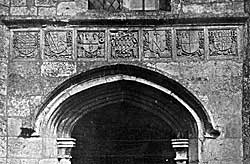
Holme church, south porch.
First to catch the eye on entering the churchyard gate are the seven shields of arms across the front of the porch. They are:—
Quarterly of eight. One and four BARTON, two amid three RATCLIFFE, five and eight ASSHETON, six amid seven LEIGH. The letters R and B are cut on either side of this shield and below it two sprigs of oak.
2. LONGVILLIERS (borne also by Stanhope) impaling MOLYNEUX with the letters I and S on either side.
3. On a fesse between three buck’s heads cabossed, a mullet. The letters I and B on either side a sprig of oak and a dolphin embowed; below it the rebus, two bears with tuns.
4. The arms of the Merchants of the Staple of Calais, with on one side a falcon, on the other two snakes intertwined and below two sheep.
5. A merchant’s mark, with the letters I and B on either side below two bales of wool, each bearing three estoiles of six points in fesse.
6. BARTON impaling BINGHAM, with the letters I and B on either side.
7. BARTON impaling quarterly, one amid four RATCLIFFE, two and five LEIGH, three and six ASHTON, with the letters R and B on either side and two sprigs of oak below.
On one of the buttresses of the tower, and on either Side of the west window the arms of the staple merchants and the merchant’s mark on shield 5 again occur. Some of the members will remember the Barton shields on the buttresses at North Muskham, visited in 1902.
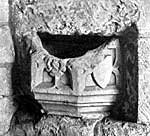
Holy water stoup, Holme church.
In the porch will be noticed a holy water stoop with pannelled sides. The old bier hangs on the wall inside the tower. The present parish registers do not begin until 1711, though when Dickinson wrote 100 years ago they were extant from 1569. Some transcripts of the 17th century remain among the muniments at Southwell, and were printed by this Society in 1903.—Record Series, vol. 1.
The Rue Fern may be observed growing on the south face of the tower.
